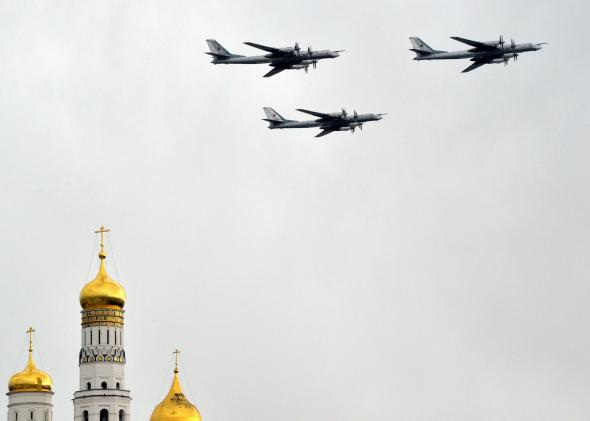According to NATO, jets from its member states scrambled earlier this week to intercept four different groups of Russian aircraft in the space of 24 hours. In the largest incident, four Tupolev Tu-95 strategic bombers and a refueling tanker were tracked by Norwegian, Portuguese, and British fighters over the Norwegian Sea and the Atlantic Ocean. In another case, two Tu-95s were tracked by Turkish aircraft over the Black Sea. Other incidents involved planes from Germany as well as non-NATO members Sweden and Finland.
These types of events aren’t that unusual—there have been about 100 intercepts this year—but the frequency of them is. None of these cases involved Russian military planes actually entering another country’s airspace, though that did reportedly happen last week when an Ilyushin-20 spy plane entered Estonian territory for about a minute according to that country’s government. That followed a still-unresolved incident in September when an Estonian intelligence agent was seized in a cross-border raid and taken to Moscow.
There was also a bizarre case earlier this month in which Sweden launched a multi-day hunt for a foreign submarine that it believed had entered its waters. The “Hunt for Reds in October” quickly descended into farce with a local fisherman being mistaken for a Russian spetsnaz commando and the supreme commander of Sweden’s armed forces describing the situation as “plainly and simply fucked up.” The hunt was eventually called off, but many felt it exposed the Swedish military as not all that prepared to counter potential threats.
Putting aside the Swedish submarine situation, which very well might have been a false alarm, Russia’s military does seem to be testing the defense of its neighbors in Europe and occasionally across the Arctic Circle in North America. This is happening at a time when the region is becoming increasingly militarized as a result of the conflict in Ukraine.
This doesn’t necessarily mean Russia is preparing for war, and open conflict between Russia and NATO countries still seems pretty unlikely. It probably has more to do with Russia seeing how much it can get away with, and making it clear that it disapproves of Europe’s pro-Ukraine stance. But as June’s shootdown of a Malaysian airliner demonstrated, tragedies can happen when there are itchy fingers on the triggers of anti-aircraft missiles.
